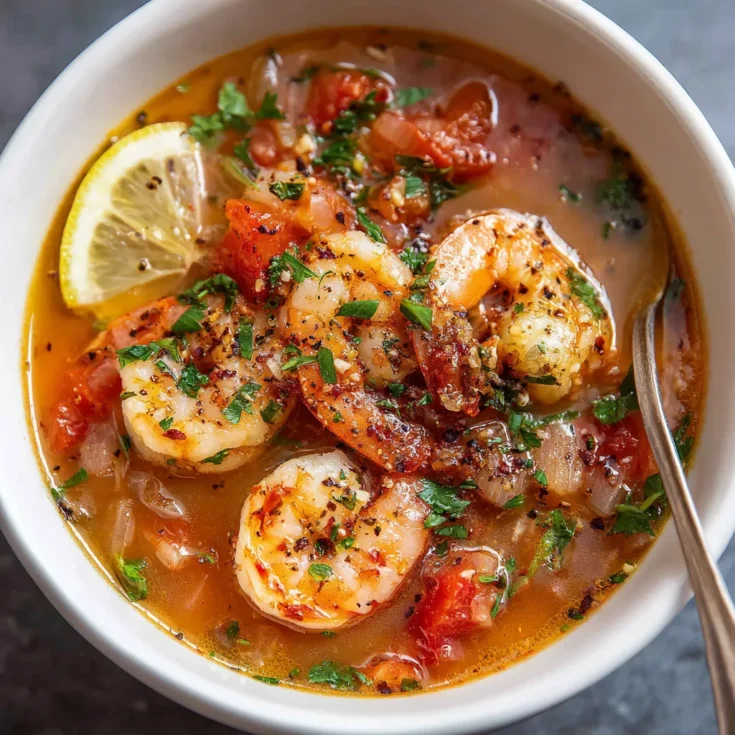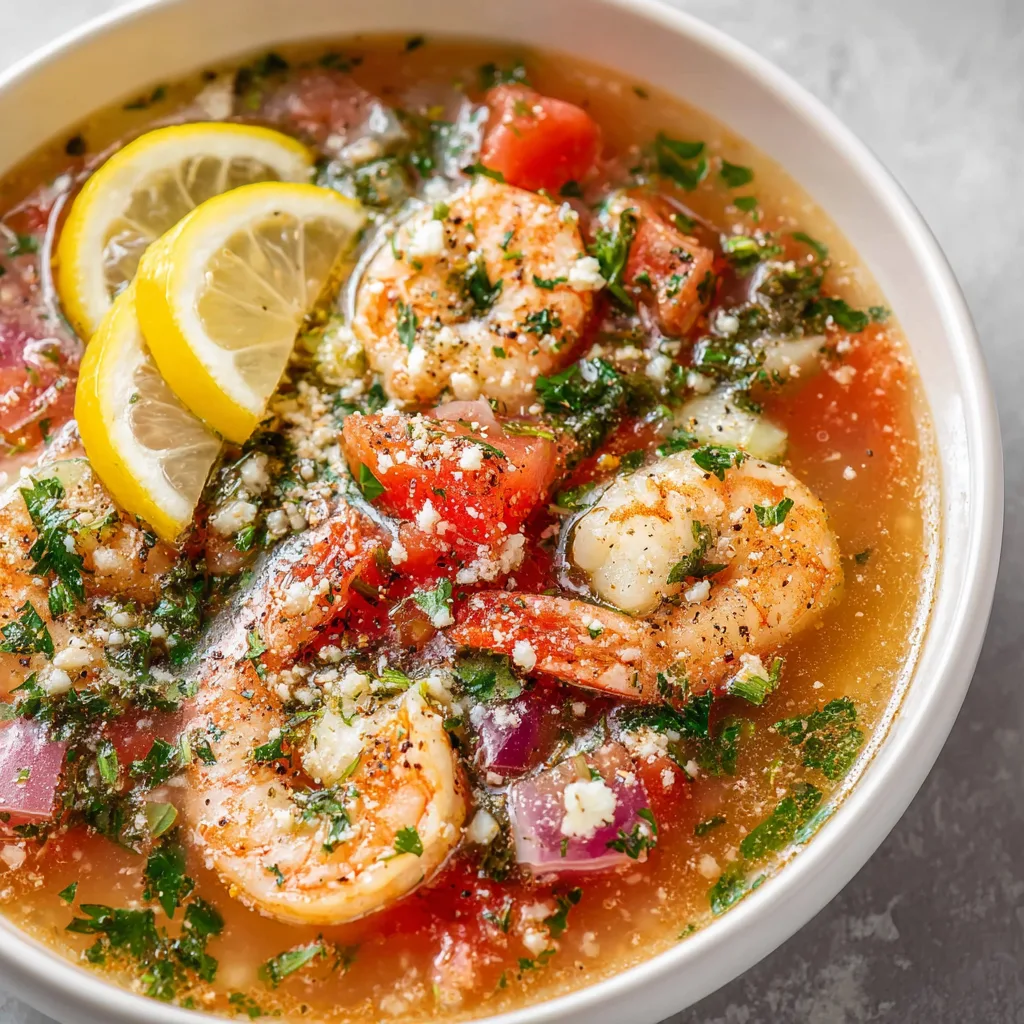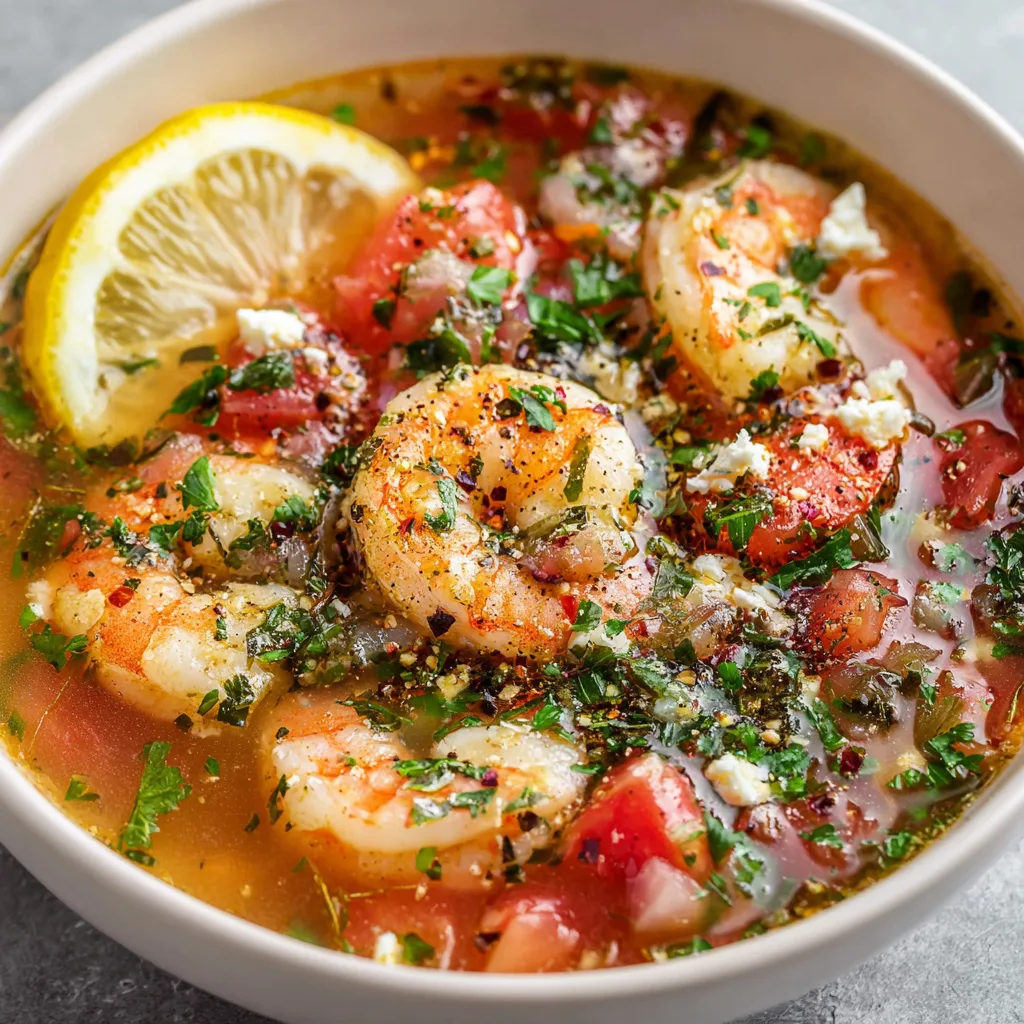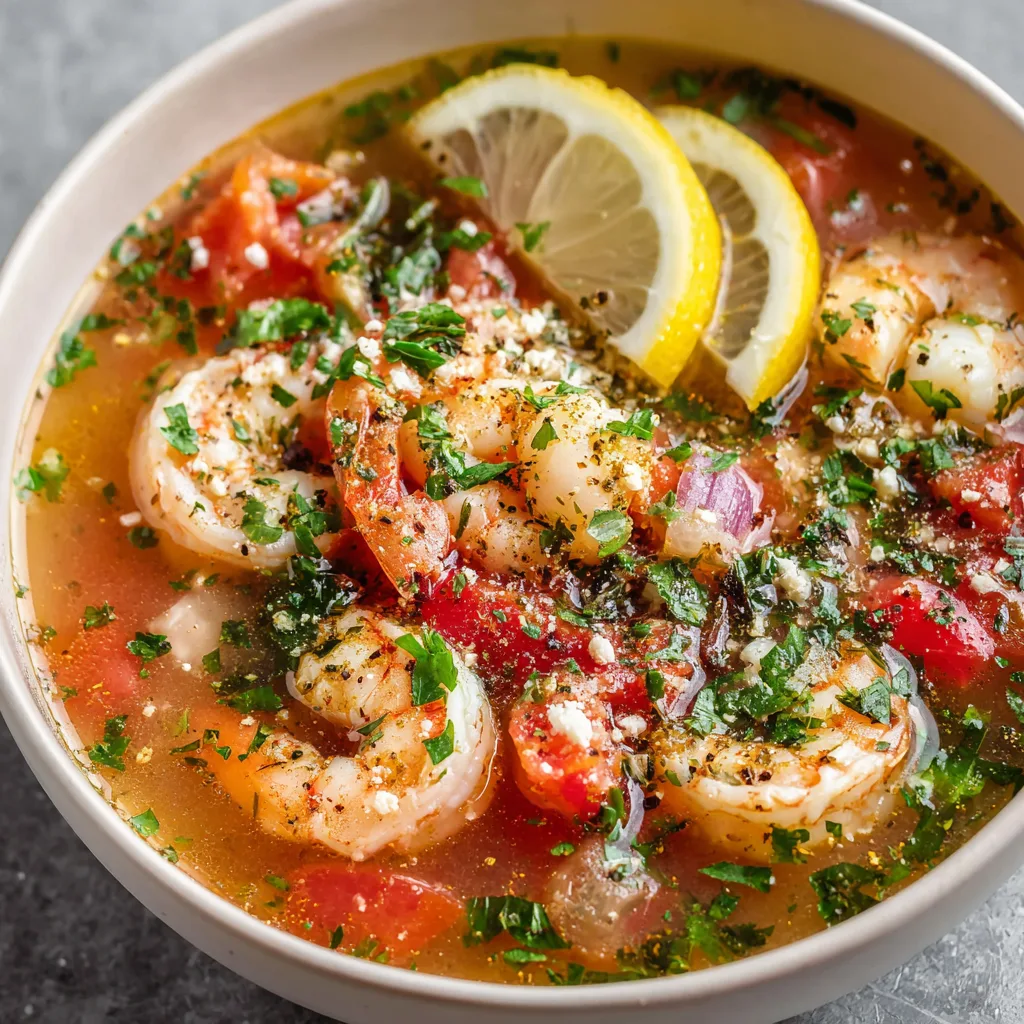Mediterranean cuisine has long held a special place on the world’s table. Its charm lies in its simplicity—vibrant herbs, golden olive oil, and fresh seafood come together to create meals that are both wholesome and indulgent. This soup celebrates all those flavors in one quick and satisfying pot.
What makes this shrimp soup stand out is its balance of convenience and depth. In just about 30 minutes, you can bring together a dish that tastes slow-cooked but fits into any busy schedule. It’s light yet hearty, bold yet clean, perfect for lunch or dinner year-round.
In this article, you’ll explore why this Mediterranean shrimp soup deserves a spot in your regular meal rotation. You’ll learn about its health benefits, ingredient swaps, cooking tips, and delicious variations inspired by regional traditions. We’ll also answer top questions and close with a complete, printable recipe card. Let’s get cooking.
Health Benefits of Mediterranean Shrimp Soup
This soup isn’t just tasty—it’s loaded with nourishment. Shrimp provides lean protein that supports muscle health without excess fat. The broth base, often filled with garlic, onion, tomatoes, and leafy greens, offers antioxidants, vitamins, and fiber.
Healthy fats from olive oil enhance absorption of those nutrients while supporting heart health. Herbs like oregano and parsley boost flavor naturally, reducing the need for salt or heavy cream.
One of the biggest perks? This soup saves time. With simple steps and quick-cooking ingredients, it’s on the table in under 30 minutes. It’s an ideal choice for weeknights or meal prepping.
Even better, it adapts easily. You can make it gluten-free by skipping pasta or low-carb by swapping grains for more greens. The flavors stay bright no matter your dietary needs. This soup works for nearly everyone, and that’s a big part of its appeal.
Key Ingredients for the Best Mediterranean Shrimp Soup
Creating a deeply flavorful Mediterranean shrimp soup begins with selecting the right ingredients. Each component plays a vital role in building layers of taste, texture, and aroma. Let’s break down the essential building blocks.
Shrimp: Choosing the Right Type
Shrimp is the star of this dish, so choose wisely. Medium to large shrimp work best, as they hold up during cooking without turning rubbery. Go for peeled and deveined shrimp to save prep time. If you’re after deeper seafood flavor, consider using shrimp with the heads on—just remember to remove them before serving. The key is not to overcook them; they only need a few minutes to turn tender and opaque.
Soup Base: Tomato Broth or Creamy Coconut
The base of your soup defines its character. Mediterranean shrimp soup usually leans toward a tomato-forward broth made from crushed tomatoes, tomato paste, and vegetable or seafood stock. This mix gives it body and depth while allowing herbs to shine.
Want a richer, creamier version? A coconut milk base creates a silky texture and a slightly sweet undertone. This Brazilian-inspired twist still uses Mediterranean aromatics, but with a tropical feel. Both styles offer bold flavors—you simply pick your preference.
Aromatics and Vegetables
A good soup begins with aromatics. Sauté chopped onions and garlic first to form the foundation. Add bell peppers, celery, or carrots for natural sweetness and bulk. These vegetables not only contribute to taste but also boost the soup’s nutritional value.
Mediterranean Herbs and Spices
Herbs are essential in capturing that sun-soaked Mediterranean essence. Oregano delivers earthy depth. Parsley brings brightness. Dill adds a hint of freshness that complements seafood. A pinch of crushed red pepper flakes adds gentle heat without overpowering the dish. Seasoning at each stage builds a robust, layered flavor.
Grains for Heft and Comfort
To make the soup heartier, add a small pasta like orzo or a scoop of cooked rice. Both soak up the broth beautifully and transform the dish into a full, satisfying meal. For gluten-free options, rice or quinoa work perfectly.
Ingredient Substitutions and Flavor Variations
Mediterranean shrimp soup is adaptable, which makes it a great kitchen staple.
Alternate Seafood Choices
No shrimp on hand? Try scallops or firm white fish like cod or halibut. These hold their shape and absorb flavors well.
Vegetable Swaps
Boost color and nutrition with spinach, kale, or corn. White beans can add creaminess and fiber, turning this into a protein-packed option. You can also skip carrots or celery if needed—just use what’s fresh and in season.
Flexible Herbs
Basil gives a sweet, peppery lift. Cilantro adds a citrus note. Chives lend a subtle onion finish. Feel free to mix and match based on what you have.
Dietary and Flavor Twists
For gluten-free versions, skip orzo and double the greens. If you need it dairy-free, avoid cheese garnishes and creamy thickeners.
Craving something bold? Add feta for a Greek saganaki-style twist, or go for the coconut variation if you prefer a creamy Brazilian touch. No matter how you build it, this soup stays vibrant and deeply satisfying.
Step‑by‑Step Cooking Guide for Mediterranean Shrimp Soup
Cooking Mediterranean shrimp soup is fast and simple when broken into clear steps. Each stage builds flavor while keeping the cooking process stress-free.
Step 1: Sear Shrimp for Maximum Flavor
Begin by heating a tablespoon of olive oil in a large pot over medium-high heat. Once hot, add the shrimp in a single layer. Let them sear undisturbed for about 1 to 2 minutes per side. This quick browning adds depth to the soup and locks in flavor. Remove the shrimp and set them aside to prevent overcooking.
If you’re using scallops or firm fish, follow the same method. Searing builds a golden crust and releases flavorful bits that enhance the broth later.
Step 2: Sauté Aromatics and Vegetables
Lower the heat to medium. Add diced onions, garlic, and chopped vegetables such as bell peppers, celery, or carrots. Sauté for 5 to 7 minutes, stirring occasionally until softened and fragrant. This step creates the aromatic foundation for your soup, giving it a warm, home-cooked base.
Step 3: Build the Broth
Once your vegetables are tender, stir in tomato paste to deepen flavor and add a rich red color. Pour in diced tomatoes and your chosen broth—vegetable, seafood, or chicken. Stir well, scraping up any browned bits from the bottom of the pot. Bring the mixture to a gentle simmer.
Step 4: Add Grains for Texture
Toss in orzo, rice, or another grain at this stage. Stir to prevent sticking. Cook uncovered until the grains are tender but not mushy. This usually takes 7 to 10 minutes, depending on the grain used.
Step 5: Return the Shrimp and Finish
Lower the heat and gently return the shrimp to the pot. Add leafy greens like spinach or kale, fresh herbs, and a squeeze of lemon juice. Let everything cook for 2 to 3 minutes—just enough to warm the shrimp and wilt the greens. Then, remove the pot from heat. The shrimp will finish cooking with residual heat, keeping them juicy and tender.
Shrimp Cooking Times and How to Spot Doneness
Getting the timing right on shrimp is crucial. Overcooked shrimp turn rubbery fast. Here’s what to keep in mind:
-
Searing Time: 2 minutes per side is ideal for medium to large shrimp.
-
Simmering Time: Once added back into the broth, shrimp need only 2–3 more minutes.
-
Visual Cues: Shrimp are done when they turn pink, curl slightly, and become opaque.
-
Carry‑Over Cooking: Always remove the soup from heat once shrimp are just cooked. The hot broth will continue to cook them slightly as they sit.
By following these timing tips, you’ll serve shrimp that’s perfectly tender every time.
Flavor‑Boosting Tips for Bold Mediterranean Taste
To make your soup unforgettable, focus on balance and smart seasoning. These techniques turn good into great:
-
Add Lemon Juice Last: Fresh lemon brightens every bite. Stir it in right before serving to preserve its citrusy lift.
-
Layer Your Spices: Start with dried oregano early for depth. Finish with red pepper flakes for gentle heat.
-
Balance the Trio: Taste for saltiness, acidity, and heat. Add more lemon if it’s flat, or a pinch of salt if flavors feel muted.
-
Deglaze the Pan: After searing shrimp, use a splash of broth to scrape up flavorful bits stuck to the pot. This small step adds rich, savory undertones to your soup.
These flavor tips work in harmony with the Mediterranean profile—fresh, bright, and full of life.
Mediterranean Regional Twists on Shrimp Soup
Mediterranean shrimp soup adapts beautifully to different regional styles, each with its own flavor profile and ingredient focus. These cultural takes add depth and inspiration to the base recipe.
Croatian “Alla Buzara” Twist
In coastal Croatian cuisine, the alla buzara style is a classic seafood preparation. It uses garlic, parsley, tomatoes, and olive oil as its base. While traditional versions often include white wine, you can skip it and still capture the essence. The focus is on rich, garlicky tomato broth and the natural brininess of the seafood. Add a handful of fresh herbs and a drizzle of olive oil just before serving for an authentic finish.
Greek Saganaki-Style Soup
Greek saganaki is known for bold tomato flavor and creamy feta. Transform your shrimp soup with crumbled feta stirred in during the last few minutes of cooking. The cheese melts slightly, adding creaminess and tang. Enhance the profile with oregano, garlic, and a pinch of chili flakes. For a full Greek twist, serve with warm pita or a lemon wedge on the side.
Italian Ciuppin Inspiration
Ligurian ciuppin, a rustic Italian fish soup, blends assorted seafood with a tomato broth rich in vegetables. You can recreate this vibe by mixing shrimp with other firm fish, like cod or sea bass, and using a thick tomato base loaded with sautéed onions, garlic, and carrots. Simmer it slowly and serve with crusty bread for an Italian coastal experience.
Global Shrimp Soup Variations Worth Trying
Mediterranean flavors travel well. Several international styles work perfectly with shrimp and offer delicious alternatives to the traditional tomato-based version.
Brazilian Moqueca-Inspired Variation
Brazilian moqueca is a tropical seafood stew with bold flavor and creamy texture. Adapt it by replacing tomatoes with coconut milk, and add rice or diced sweet potatoes for body. Finish with lime juice and chopped cilantro. The result is rich, fragrant, and silky, yet still light enough for a quick meal.
White Bean and Olive Fusion
For a pantry-friendly version, try white beans and olives as your base. These ingredients bring both protein and richness, while chopped tomatoes and greens keep things fresh. Season with oregano and lemon zest for a bright Mediterranean finish. It’s simple, filling, and entirely customizable.
Dietary Adaptations for Every Lifestyle
This soup works with nearly any diet by adjusting a few key ingredients.
-
Gluten-Free Option: Replace orzo with rice, quinoa, or skip grains altogether. The soup remains hearty and satisfying.
-
Dairy-Free Version: Use olive oil and a tomato base. Skip any cheese garnish or opt for coconut milk for creaminess.
-
Low-Carb Choice: Omit grains and double the vegetables. Add extra greens like kale or spinach for nutrition and volume.
-
Vegan or Vegetarian Twist: Substitute shrimp with portobello mushrooms or eggplant. These options hold texture well and soak up the flavorful broth beautifully.
With so many options, Mediterranean shrimp soup becomes more than a single recipe—it’s a flexible framework for endless delicious meals.
Frequently Asked Questions About Mediterranean Shrimp Soup
Every great recipe sparks a few questions, especially when working with quick-cooking seafood like shrimp. Here are the most common concerns, answered simply and clearly to help you perfect your soup.
How do I store and reheat shrimp soup?
Store your leftover shrimp soup in an airtight container in the fridge for up to 3 to 4 days. For best results when reheating, warm the broth and vegetables gently over medium heat. Add the shrimp only during the final minute or two, just long enough to heat through. This method avoids overcooking and keeps the shrimp tender.
Can I freeze this soup?
Freezing is possible but not ideal if the soup contains shrimp and orzo. Both tend to lose texture after thawing. Instead, freeze the broth and vegetables separately. When you’re ready to serve, reheat the base, then add fresh shrimp and any grains just before serving.
Why did my shrimp fall apart in the soup?
Shrimp can fall apart if they’re overcooked or too small. Always choose medium to large shrimp for better texture. Sear or simmer them briefly—no more than 4 to 5 minutes total. To be safe, cook them last and remove the soup from heat immediately afterward.
Why did my orzo stick to the bottom?
Orzo needs regular stirring to cook evenly in broth. If left unattended, it can settle and stick. Stir every few minutes while it simmers. If something does stick, don’t scrape the bottom—it can cloud the broth and release burnt flavors.
How long should I cook shrimp in soup?
Shrimp cook quickly—about 2 minutes per side when searing. Once returned to the soup, they need only another 2 to 3 minutes to finish. Stop cooking as soon as they turn pink and opaque. Letting them sit in hot broth off the heat will finish the job gently.
Quick Mediterranean Shrimp Soup – Light, Flavorful & Ready in 20 Minutes

A vibrant, hearty one-pot soup that combines succulent shrimp, fresh veggies, tangy tomato broth, aromatic herbs, and a burst of lemon—ready in just 30 minutes.
Ingredients
- 1 lb raw shrimp, peeled and deveined
- 1 Tbsp olive oil
- 1 small onion, chopped
- 2 garlic cloves, minced
- 1 bell pepper (any color), diced
- 1 cup diced tomatoes (or 1 Tbsp tomato paste)
- 4 cups broth (vegetable or chicken)
- ½ cup orzo (or rice/quinoa for gluten-free)
- 2 cups fresh greens (spinach or kale)
- 2 Tbsp fresh parsley; optional 1 Tbsp dill
- Juice of ½ lemon
- ½ tsp dried oregano
- Pinch of crushed red-pepper flakes
- Salt and pepper to taste
Instructions
▢ Heat oil in a large pot over medium heat. Sear shrimp for 2 minutes per side. Remove and set aside.
▢ Sauté onion, garlic, and bell pepper until softened, about 3–4 minutes.
▢ Stir in diced tomatoes or tomato paste and oregano. Cook for 2 minutes.
▢ Pour in broth and bring to a simmer.
▢ Add orzo or grain and cook for about 7 minutes, stirring occasionally.
▢ Return shrimp and greens to the pot. Cook for 3 minutes until shrimp turn opaque.
▢ Stir in parsley, lemon juice, salt, pepper, and red pepper flakes.
▢ Taste and adjust seasoning. Let rest off heat for 2–3 minutes.
▢ Serve hot with crusty bread or a fresh side salad.
Notes




